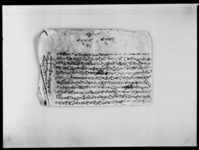A copy of a letter from Kaparadāra Kālidāsa Khaḍkā re the worship of Śrī Bhagavatī at Palāñcoka (VS 1841)
ID: K_0579_0071
Edited and
translated by Astrid Zotter
in collaboration with
Pabitra Bajracharya
Created: 2022-06-13;
Last modified: 2023-01-10
For the metadata of the document, click here
The accompanying edition, translation/synopsis and/or commentary are available under the terms of the Creative Commons Attribution-ShareAlike 4.0 International License
Abstract
In the document of which this is a copy, Kaparadāra Kālīdāsa Khaḍkā orders the division of a field at Palāñcoka's Rānīpokhari measuring 100 murīs. From one half, rice offered in daily worship to Śrī Bhagavatī of Palāñcoka is henceforth to be provided under the management of Bhagavanta Bāḍā. From the other half, sacrificial animals and other worship items needed during both Dasaĩ festivals are to be provided under the supervision of the members of a trust (guṭhi).Diplomatic edition
[2r]
1सही1सकल्वमोजिंनकल्दुरुस्तछभनी2सहिछाप्गर्न्याकरुणानंदगोभाजु[...]
3षंवाहाल्¯¯¯¯¯¯¯¯¯1श्रीदुर्गासाहाय1श्रीवडामहाराजा
2१1श्रीभगवति
2२1⟪१९⟫1स्वस्तिश्रीकपर्दार•कालिदासषड्का.कस्यलिषापत्रम्¯¯¯ ¯¯¯ ¯¯¯ ¯¯¯ ¯¯¯ ¯¯¯ ¯¯¯ ¯¯¯ ¯¯¯
2आगेपलांचोककोरानिपोषरिषेतमुरीसये१००¯ ¯१¯ले¯ ¯२¯कननित्यपूजाकोअक्षेता
3भनीचर्हायाकोहोदुईतिनवर्षअक्षेतैगरिचर्ह्योथ्यो•पछिसर्का•रविन्तिनगरीकनगुठभ
4य़छ•तस्कारणमुष्यसवैषेतअछेतारहन्याहोपरंतुगुठपनिचलाऊभंनालेरानीपोष
6रिकोसयमुरिषेतमध्येमुरिपचासषेत⟪स्ही⟫⟪[?]णा ⟫अछेताकनर•भूजोलनसराजामगरी•नित्य
7पुजा•गर्नुगरी•भगवन्तवाडाकाहाताराष्यऊमुरिपचास्षेतगुठीजनकाहात्राषी
8चैत्र⟪अ⟫ष्टमिकोदिनरांगो१वोक्या१भेटदक्षिणादिपदानकेरुपैञा१आश्विनिदसैकेरां
9गो१वोक्या१भेटदक्षिणादिपदान•पंचोपचार•पुजासामग्रि⟪ स्ही⟫हिसमेतपूजागर्नु
10गरिदिञौँयेतिपुजामहांजसलेघटाउला•पंचमाहापातकलागला•पुजावनाईगर्नु
11नैवैड्यजस्को•दस्तुरज्माहोसोसोवाडीषानुगरी•लेषिदिञौंईतिसम्वत्१८४१साल्
12माघवदि६रोज७मुकाम्•कांतिपुरराजधानीशुभ्ंम्¯¯¯ ¯¯¯ ¯¯¯ ¯¯¯ ¯¯¯
Translation
[1r]
[In the left margin:]
Signature [of the attestator]:
The one who attested that the copy is true to the original: Karuṇānaṃda Gobhāju, ...khaṃ Bāhāl1
[Invocatio:]
May Śrī Durgā help!
[Space above the main text:]
Śrī Baḍā Mahārājā2 – 1
Śrī Bhagavati – 2
[Addition above the main text:]
193
[Main text:]
Hail! A written letter of Śrī KaparadāraKālidāsa Khaḍkā
Āge: 100—[in words] one hundred—murīs of irrigated land (kheta) at Palāṃcoka's Rānipokhari were dedicated to [Śrī Bhagavati]4 by [Śrī Baḍā Mahārājā]5 in order to [provide] akṣatā for daily worship. For two to three years akṣeta was indeed produced and offered. Later the trust (guṭha) [for managing the Dasaĩ rituals] came into being (i.e. started operating) without its being announced (lit. "making petition") to His Majesty's Government (sarkāra). Therefore the whole field continued mainly to [produce] achetā [for daily worship]. But because [the original land grant] states: "Also operate the guṭha," we put fifty muris of the hundred murīs of kheta at Rānīpokhari under the charge of Bhagavanta Bāḍā for performing the daily worship (nityapūjā)—for preparing acheta and cooked rice6 . We have issued [another order saying:] "Put fifty muris under [the charge of] the guṭhī personnel and perform worship on the day of caitrāṣṭamī [with] 1 he-buffalo, 1 he-goat, 1 rupee for a gift of lamps (dīpadāna), bheṭa and dakṣiṇā; during the Dasaĩ in Āśvina [with] 1 he-buffalo, 1 he-goat, bheṭa, dakṣiṇā, a gift of lamps, [and] material for the worship with five offerings (pañcopacārapūjā). He who makes reductions to these pūjās will be tainted with [sin equal to that resulting from] the five grave sins (pañcamahāpātaka). Make [preparations for] and perform the worship. We have written down [the rule] that he whose whose customary obligation (dastura) it is [to produce?] food offerings (naivaiḍya for naivedya) shall enjoy the profit/homestead (bāḍī) [connected with it]. 7
Saturday, the 6th of the dark lunar fortnight of the month of Māgha in the [Vikrama] era year 1841 (1785 CE).8 Station: Kāṃtipura, the capital. Auspiciousness.
Commentary
The document is part of a batch of copies microfilmed from K_0579_0055 to K_0580_0004.9 All of them concern rituals and priestly rights at the temple of Śrī Bhagavatī of Palāñcoka and landed properties dedicated to their support. They all carry the archival numbers Ta. no. 1339 and Gu. Ba. no. 12 and feature running numbers between 1 and 41, the present document being no. 19 (see note above). The copies were probably made in connection with a quarrel in VS 1975 when Karuṇānanda Gubhāju issued a complaint against other priests, among them one Ṣaḍānanda, for misappropriating property belonging to the deity (K_0579_0055). The veracity of the copies of this and most of the other documents in the batch was certified by Karuṇānanda, and a few of them by Ṣaḍānanda. In his petition, Karuṇānanda quotes the present document and also states that the 100 murīs at Rānīpokharī were originally dedicated by Pṛthvīnārāyaṇa Śāha (śrī pṛthvīnārāṃ sāhāvāt rānīpokharī ṣet murī 100 kā vālīle śrī bhagavatīkana nityepujā gardā achetā ra bhujolaṃ bhoga lagāūnu). In K_0580_0002, too, Pṛthvīnārāyaṇa is referred to as the donor of the field.
Related documents include another letter, dated VS 1840 (1783 CE), from Kaparadāra Kālidāsa Khaḍkā authorizing Bhagavanta Bāḍā10 to perform the worship of Śrī Bhagavatī (K_0579_0062). In a follow-up letter from VS 1844 DevānaAbhimāna Siṃha [Basnyāt] writes to local officials (copies preserved as K_0579_0067 and K_0579_0064) reinforcing the arrangement formulated in the present document, which he refers to as a missive (daskhata) of the kaparadāra (kapardārako dasaṣata, K_0579_0064). Another document from the same year sent by Devāna Nāhāra Siṃha [Basnyāt], Abhimāna Siṃha [Basnyāt], Dhaukala Siṃha [Basnyāt] and Jahara Siṃha [Basnyāt] even quotes the present document verbatim (K_0579_0072).
The document concerns landed property endowed to fund rituals at the famous Bhagavatī temple of Palāñcoka. The kaparadāra fixes the rule that the field originally endowed by the king is to be divided in equal shares between the priest (Bhagavanta Bāḍā) and unnamed personnel, the latter charged with operating the guṭhi. From the list of items to be provided, it is clear that Bhagavanta Bāḍā would be responsible for the nityapūjā, while the guṭhi was to take care of worship during both Dasaĩ festivals.11 The establishment of such a guṭhi also must have been part of the original endowment, but apparently it only started operating some years later and without officially announcing the implementation of the royal deed to the government. In this situation the present order clarifies the scheme under which the produce of the land originally endowed would have to be shared between these two parties involved, effectively constituting a curtailment of rights over the land by Bhagavanta Bāḍā, who had used the produce of the land alone so far.

